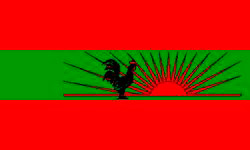The Day My Cuban City Was Occupied by the Military
Dmitri Prieto

HAVANA TIMES — My mom had asked me to buy some tomatoes for lunch, but a big combat helicopter had just landed on the field of the baseball stadium behind our apartment building.
It was a camouflaged Soviet chopper with insignias that aren’t used by the Cuban military. I realized it belonged to the air force of the FAPLA (Armed Liberation Forces of Angola). Its engine and propeller making a lot of noise, the flying machine swallowed up military personnel stationed at the stadium and took off to fly around my city Santa Cruz del Norte.
A bit further up, supersonic fighter planes were flying over the town. Later, I found out that the rustic, tile roofs of several houses in poor condition collapsed under the sonic impact of the jets.
The ripe-red tomatoes I like and my mom used to like were sold at the agricultural and livestock market some blocks from the house, wedged between five-story, pre-fabricated tenement buildings. I forayed into the space between the buildings.
An olive-green military truck that turned into the narrow street startled me and then lost itself in the small, concrete jungle known as the “development zone” in our quiet coastal town.
In the distance, one could already make out the farmers selling the fruits of the earth.
When I turned to approach them, I saw hundreds of well-built black men. Bearded and dressed in fatigues, they carried rifles and other automatic weapons. As I walked past the troop towards the tomato stand, I noticed that their assault arsenal not only included AK 47s, but M-16s as well.
The fellas looked tired. Civilians of different skin-colors, dressed Cuban-style, walked briskly past them and addressed the occasional words to the men in uniform.
The bearded black men didn’t pay much attention to tomato-buyers such as myself. I, however, did sneak a peek at the insignias embroidered on the sleeves of their shirts.

In them, a black rooster stood before the sun, rising in the background. I had never seen that badge before, but I knew, from stories I’d heard, that it was the logo of UNITA, the National Union for the Total Independence of Angola, a rebel guerrilla led by Jonas Savibmi that enjoyed the support of Mobutu’s Zaire, Maoist China, apartheid South Africa and the CIA. They had fiercely engaged the FAPLA and Cuban troops during the war in Angola.
When I saw that the members of the UNITA troop spoke perfect Spanish, sometimes with the accent typical of our island’s eastern end, I felt somewhat relieved. They started to sit under the trees to wait for their orders. As I began to leave with the bag of tomatoes, having accomplished my mission, a number of trucks with large film cameras began to arrive.
The two FAPLA jets and the helicopter flew over my city several times more, but their adversaries didn’t seem too interested in opening fire.
I later got wind that the Cuban army excused itself for the collapsed roofs and even paid for their repair. The following day, our small town awoke to find itself completely demilitarized. The enemy soldiers didn’t even leave empty cola cans strewn across the city’s streets. They were very polite, in fact.
The Cuban film Sumbe hit movie theaters some months later. It’s a shame I haven’t yet been able to see it.
My mom went off to live to the other side of reality a year after the shoot. I remember her every time I see news on TV of that which, until one day, was as much her country as it is mine.
Neither her nor I – nor anyone I know, for that matter – have had to go through the experience of a military occupation or urban warfare. I know there’s no comparison, but, when I see images of the Ukraine, Iraq, Syria or some other country in conflict today, my heart begins to pound with tension. I cannot help but conjure up the living memory of that brief experience – politically fictitious but cinematically real – of walking through a familiar, occupied city.





